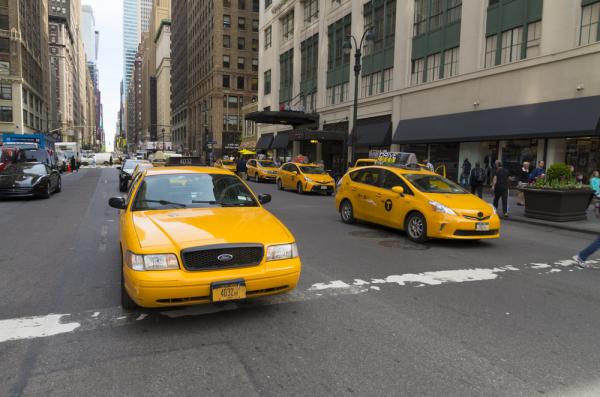Starting off with one broad (but bulletproof) generalization, the folks at the Massachusetts Institute of Technology are a pretty sharp bunch. They can analyze and project and theorize with the best of them, using computer models to do anything and everything – and much, much more often than not they leave those of us enamored with science and math in a wonderous, awe-inducing state.
But – and after that introduction, you knew a "but" was coming – on rare occasions all that supercharged brain power gets tripped up by the darnest things.
So in response to a new MIT study projecting that innovative carpooling on the streets of New York City can create unimaginable reductions and euphoric efficiencies in taxi traffic, may I politely suggest that those brilliant researchers considered everything – except for one tiny, incalculable detail ...
... the psyche of the demanding New York taxi passenger.
Their conclusion, summed up in a MIT release titled, "Carpooling Apps Could Reduce Taxi Traffic by 75%," is built upon technological advances created by the ride-sharing companies Lyft and Uber. The research team developed an algorithm that "works in real-time to reroute cars based on incoming requests, and can also proactively send idle cars to areas with high demand – a step that speeds up service 20 percent."
And while the theory – as well as the extrapolated benefits (reduced congestion and auto exhaust, faster travel times) – is impressive, what the study banks on heavily is that passengers will agree, or be convinced to, trade in private car service for group van-dom. And that, however, is a Times-Square-sized assumption.
It's like asking a dinner patron with an empty stomach to give up a full meal for a bowl of stale Fruit Loops, just because it costs a little less. It's two completely different experiences. While MIT's computer-based simulation produces such incredible results by simply swapping one ride for the other, the entire concept of cheaper, faster taxi trips becomes as implausible as a pothole-free city when one considers the specifics.
Currently, there are more than 13,586 licenced taxis servicing New York, carrying individual riders to a single destination per ride (and on occasion, sometimes friends split a cab). Using NYC data for a specific week in May 2013, the researchers tell us, this massive fleet made between a low of 382,000 trips, and and a high of 460,000, on a given day.
 That said, the MIT team theorized that if the taxi fleet was greatly reduced, and each was a vehicle heading to a range of destinations, with multiple passengers going the same direction based on each rider's app-inputted data, then "95 percent of demand would be covered by just 2,000 ten-person vehicles, compared to the nearly 14,000 taxis that currently operate."
That said, the MIT team theorized that if the taxi fleet was greatly reduced, and each was a vehicle heading to a range of destinations, with multiple passengers going the same direction based on each rider's app-inputted data, then "95 percent of demand would be covered by just 2,000 ten-person vehicles, compared to the nearly 14,000 taxis that currently operate."
What's that? Ten-person vehicles?
That's called a van. And a van is not a taxi. Or a car, as in "carpool." Not by a long shot.
A taxi of course, is a private car, where one rides alone, while a van is filled with strangers – who frequently talk on their phones, sometimes eat and occasionally possess or emit malodorous scents.
The study, titled "On-demand high-capacity ride-sharing via dynamic trip-vehicle assignment," was published last week in the Proceedings of the National Academy of the Sciences.
If this type of group service is unconvincing as a solution, as an alternative "3,000 four-passenger cars could serve 98 percent of taxi demand in New York City, with an average wait-time of only 2.7 minutes," according to Professor Daniela Rus of MIT’s Computer Science and Artificial Intelligence Laboratory. (Carpooling image above courtesy of Adam Conner-Simons, MIT CSAIL)
Fewer passengers per vehicle, but now in closer proximity to one another. Different vehicle, same problem.
So, what we have here is a theory that requires wishful thinking and a great deal of passenger cooperation. But then the research team adds this little nugget, to cement the idea that this carpooling concept is short on foundation but long on fantasy.
“What’s more," says Rus," the system is particularly suited to autonomous cars, since it can continuously reroute vehicles based on real-time requests.”
Yes, taxi riders in private cars voluntarily climbing into self-driving vans with a bunch of strangers. I don't ordinarily lean towards skepticism, and I'm not normally a naysayer. But if this idea is ever implemented it's going to be a long – long – time from now.
Here's a thought: Before any carpooling study like this, it might make sense to first survey actual New York City taxi passengers, to get an accurate idea of what compromises they'd be willing to make to speed their trip and save a few bucks. After all, while it's always great to think big – and that should never be discouraged – what good is coming up with a "solution" that trades one set of problems for another?




